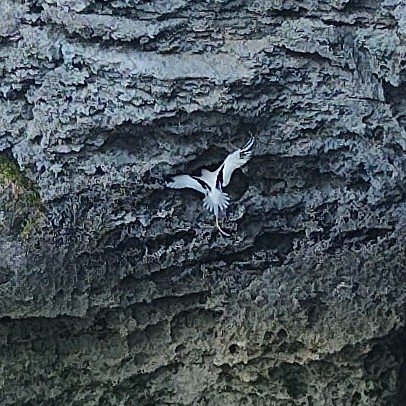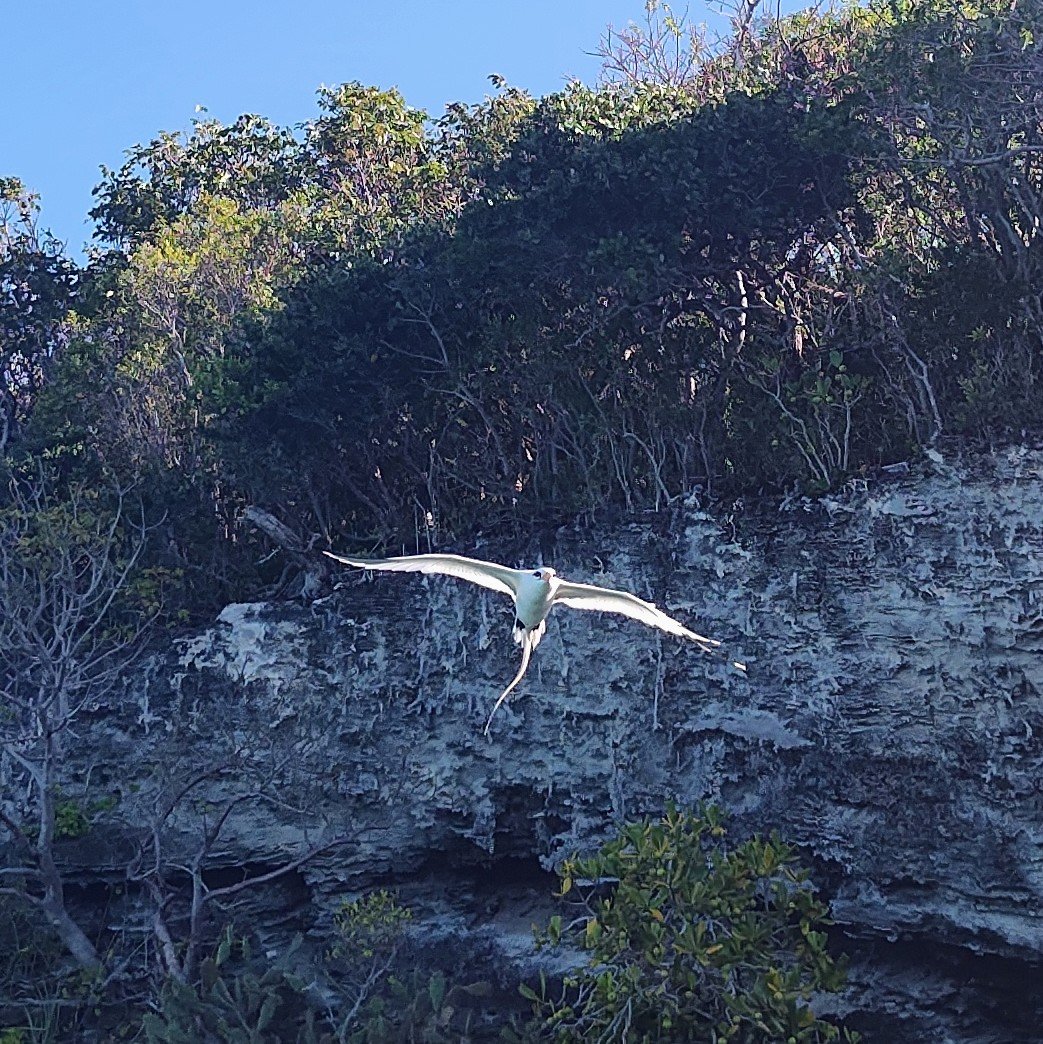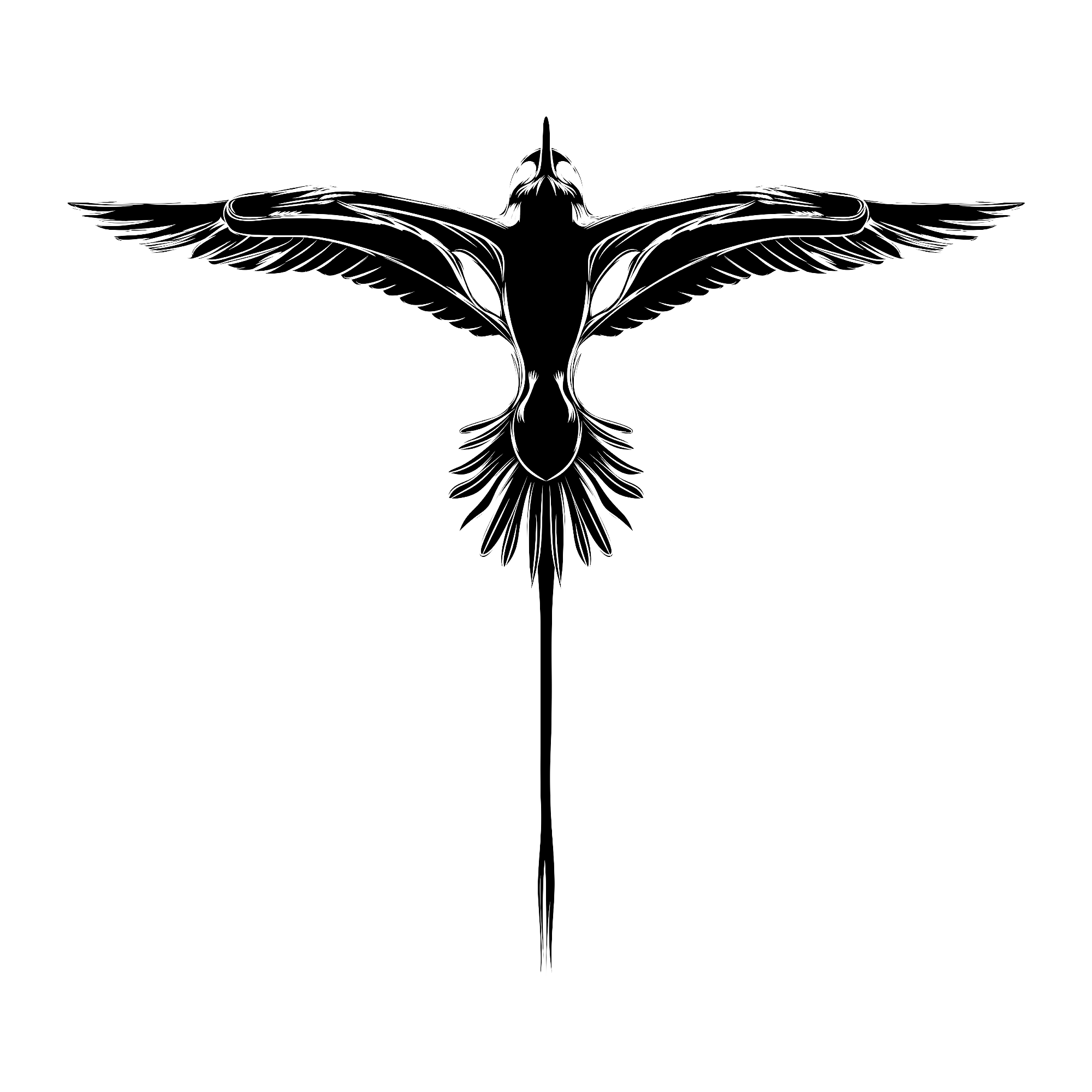The Longtails of Powell Cay
The White-tailed Tropicbirds nesting on the cliffs of Powell Cay, Bahamas
UPDATED APRIL 4, 2023
PHOTO OF WHITE-TAILED TROPICBIRD BY GREG FRUCCI, APRIL 2023 ON POWELL CAY, BAHAMAS
Powell Cay is an unpopulated, beautifully small out island in the Abacos of the Bahamas.
White-tailed Tropicbirds (Phaethon lepturus)[1] are also referred to as “Longtails” in Bermuda where they are officially protected by the government. I first encountered the bird while sailing alone to Bermuda from North Carolina back in June 2011, so I will continue to refer to them as Longtails in this paper.
As recently as March 26-27, 2023, I witnessed and filmed a colony of approximately twenty Longtails flying next to the cliffs of Powell Cay in a manner that is typical of the species mating ritual. I just happened to be anchored up on the west side of the island aboard my sailboat, the Longtail. Yes, there is a story behind the name I chose for the boat.[2]
Longtail mates, along with challengers nearby, beautifully flew in parallel and performed spectacular aerobatics in synchronization with shallow glides while speaking loudly to each other in a distinctive manner[3].
The breeding season can be continuous all year in some locations, unlike Bermuda where it only lasts a couple of months. I do not know how long the breeding season is at Powell Cay, but I would like to find out.
PHOTO OF WHITE-TAILED TROPICBIRD BY GREG FRUCCI, APRIL 2023 ON POWELL CAY, BAHAMAS
Longtails form colonies on cliffs most often. Only one egg is laid which is strongly defended. The nesting site selection is also part of the flying ritual which I witnessed[4].
According to the Bahamas National Trust paper on the Longtails, one of the threats to the White-tailed Tropicbird population is that the nesting grounds are sometimes destroyed by construction on the waterfronts[5]. In Bermuda, the same threat is mentioned where “Developers have quarried and terraced sea cliffs for residential housing.”[6]
Is the species threatened with distinction? Nobody really knows for sure. According to Birds of the World and IUCN, the White-tailed Tropicbird “populations are small but considered generally stable or slightly declining. Not listed as threatened or endangered by any government.”[7] Yet, in this same article and others[8], population trends are unknown due to the fact that the Longtails are difficult to study since they spend so much time at sea alone or in small groups and only venture to shore in order to breed. Further, it is very clear that nesting sites are threatened by construction.
Powell Cay is partially owned by “the Crown” and partially owned by an individual or corporation as of 2021. The portion that the government of the Bahamas owns is to be set aside for a Nature Preserve, but not the part of the island where the Longtails live and breed. The part of the island where the Longtails exist could be destroyed by a developer or individual who does not care about conservation. Or perhaps cares, but is unaware of the Longtails. The previous owner was either unaware or did not care. I have seen the development plan created in 2010 which would destroy the current nesting site.
As an Architect, I have met some developers and individuals who fall into the category of destroying anything in order to simply get what they want. I have also met the opposite…loving humans who protect through creation. I have faith that the Powell Cay Longtails will be protected in a creative way.
I am writing this because I am passionate about saving the Longtails of Powell Cay and everywhere else they reside in order for them to live their lives in Peace. Even alongside humans.
The White-tailed Tropicbird has been poorly studied, especially in the Americas, because of its wide dispersal, low densities in tropical seas, and the inaccessibility of its cliff nest sites.
~ David S. Lee and Marsha Walsh-McGee, 2020[9]
Powell Cay is currently not for sale. Yet, I feel so strongly about the Powell Cay Longtails, I am attempting to reach out to the current owner in a peaceful way.
UPDATE APRIL 4, 2023: This morning, I received an email from the real estate company that represents the current owner. The current owner is willing to sell the property for $7.9 million. So, someone could purchase this property with the 2010 development plan and destroy the current nesting site if they do not care about conservation. In particular, the conservation of Longtails. If I had that kind of cash, I would not hesitate to buy the island just to protect this colony of Longtails. If anyone reading this knows of an individual or organization that is capable of this level of purchase, and would not develop the property in a way destructive to the Longtails, please send this document to them and/or contact me.
If this short piece resonates with you, please feel free to reach out to me. I would love to have an intelligent conversation about the Longtails of Powell Cay. I am open to any avenue which will benefit the survival of the White-tailed Tropicbird species no matter where they reside.
Yes, it is possible for all beings to live beside each other in peace no matter the species, race, culture, or anything else which can create a sense of separation. We all come from the same place, thus we can all be in union with one another. For me at least, this is Truth.
PHOTO OF WHITE-TAILED TROPICBIRD BY GREG FRUCCI, APRIL 2023 ON POWELL CAY, BAHAMAS
[1] White-tailed tropicbird from Wikipedia Article
[2] The chapter “A Cab Ride in Bermuda” pages 85-89 in “Path of Three Hundred: Volume I” by Greg Frucci
[3] White-tailed tropicbird sounds by xeno-canto
[4] Breeding and Reproduction from oiseaux-birds.com
[5] Bahamas National Trust paper on the White-tailed Tropicbird - Threats
[6] Birds of the World – White-tailed Tropicbird Degradation of Habitat
[7] Birds of the World – Conservation Status
[8] White-tailed Tropicbird from Wikipedia Article – Conservation Status
photo by Greg Frucci of a Longtail at Powell Cay on March 26, 2023
White-tailed Tropicbird copyright, Greg Frucci 2023





